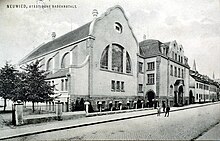Municipal bathing establishment Neuwied
The Stadtische Badeanstalt Neuwied was a bathing establishment opened on June 22, 1908 in the center of Neuwied . The founder and builder was Julius Remy (1848–1932), an honorary citizen of Neuwied . In 1985 it was closed because of holes in the swimming pool. Today the Stadtbad serves as an office complex and is a listed building.
history
The first private bathing establishment was opened in Neuwied as early as 1826. In 1847 the shipbuilder Peter Stein built a cell bath house on the Rhine, which existed until 1869. In 1870 another cell bath house with swimming school was built near today's Goethe facilities .
After the establishment of the Matthias Church in Neuwied 1899-1904, the old Catholic church in the upper Marktstrasse was demolished and the municipal bathing establishment was built at this point. The founder and honorary citizen Julius Remy appointed the architect Wilhelm Knoppe from Cologne to plan and build the bathing establishment. On May 11, 1904, the new construction of the municipal bathing establishment was approved. The construction costs were estimated at 160,000 marks, 70,000 marks came from the Julius Remy Foundation, the rest was to be raised through a 3.5 percent mortgage at the Stadtsparkasse. The construction costs were nevertheless exceeded and ultimately amounted to 271,000 marks.
opening
On June 22, 1908, a Sunday, the municipal bathing establishment was opened by Mayor Dr. Geppert, the donor and city councilor Julius Remy and the architect Wilhelm Knoppe inaugurated. For the Neuwied it was an "open day". The new bathroom was an unusual luxury for the population: the large swimming pool, loosened up by niches and galleries, plus showers and bathtubs. The citizens were enthusiastic and the newspapers reported on the modern and almost most beautiful bathroom in Germany. Many local governments sent delegations to Neuwied to find out more about the modern bathroom.
One day after the opening, the new again were allowed to swim and bathe. A shower bath cost 15 pfennigs at the time, a bath without laundry cost 40 pfennigs and swimming lessons cost 10 marks.
Saturdays and before public holidays it was of course very busy and the families wanted to go swimming together: The bathing women, employees of the city, first led those who wanted to the baths to the cubicles to wash them with soap, and to scrub them if necessary, so that they wouldn't get dirty in the tub. This quickly gave the bath women the nickname "the quarter washers".
In 1909 the association 09-Neuwied Swimming Club (NSV) was founded to promote swimming . Show swimming and competitions made the club known in and around the city. The member Hermann Heibel participated in the 1936 Olympic Games . In 1929 a "women's swimming club" was founded, which joined NSV 09 as a women's division. After the war, the women's department went into business for itself and became known as mermaids for setting up a water ballet. The local troops of the life-saving society conducted courses in the bathing establishment.
The Gymnasial Turn- und Ruderverein Neuwied (GTRVN), founded in 1882 by the high school student Georg Kolk , the oldest school and rowing club on the Rhine and the second oldest in all of Germany, carried out its exercises in the bathing establishment during the winter months, for example how to feel behaves in the event of a boat accident in the water.
renovation
After the war, many buildings in the city, including the bathing establishment, had to be renovated. In 1951 the swimming pool was modernized, the heating switched from coal to gas and a modern water regulator was installed for the swimming pool. Showers and bathtubs were renewed and the swimming pool and gallery expanded so that up to 850 seats were available for spectators at competitions. The renovated and enlarged bathing establishment could now also be used by the water sports clubs in winter.
closure
In 1985 the bathing establishment was closed due to a leaking swimming pool. Considerations of a renovation were lost because of the costs. In 1988 the bathing establishment was designated as a cultural monument and renovated from 1997 to 1999 in accordance with the requirements of the monument protection authorities.
Web links
-
In Neuwied a bath
takebuy. Drafts for a public use of the former indoor swimming pool of the city of Neuwied, published on August 2, 2010. - Agency buys old indoor swimming pool. In: Rhein-Zeitung Koblenz. on the occasion of the privatization of the indoor swimming pool, published on August 3, 2010.
- ( Page no longer available , search in web archives: postcard picture of the historic indoor swimming pool in Neuwied )
- ( Page no longer available , search in web archives: picture of the renovation of the indoor pool )
Coordinates: 50 ° 25 '44.72 " N , 7 ° 27' 40.64" E

